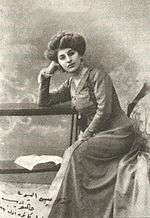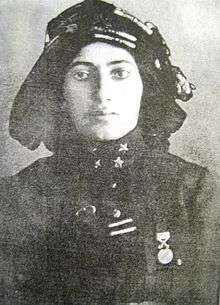Women in warfare and the military (1900–1945)
This timeline of women in warfare and the military (1900–1945) deals with the role of women in the military around the world from 1900 through 1945. By the end of the 19th century, women in some countries were starting to serve in limited roles in various branches of the military. The two major events in this time period were World War I and World War II. Please see Women in World War I and Women in World War II for more information.
For articles specifically pertaining to the United States, see: Timeline of women in war in the United States, Pre-1945.
Timeline of women in warfare from 1900 until 1945 worldwide (except present US)

Halide Edip Adıvar
1900s
- 1899–1900: Lin Hei'er commands the Red Lantern Unit of women rebel soldiers during the Boxer Rebellion.[1]
- 1900: Yaa Asantewaa, the queen mother of the Ejisu, leads the Ashanti rebellion (also known as the War of the Golden Stool) against the British in the Gold Coast (modern Ghana).
- 1901 The Canadian Army Nursing Service began in 1901.[2]
- 1904–1907: Herero warrior women fight alongside men against the Germans during the Herero and Namaqua Wars in German South-West Africa (modern Namibia).
- 1907: Korean independence fighter and activist Yun Hui-sun organizes a female militia group or "righteous army" of about 30 women, leading them in attacks against the Japanese.[3][4]
- 1908: Georgina Fane Pope became the first matron-in-chief of the Canadian Army Nursing Corps when the corps began its official existence at this time.[5]
1910s
- 1910–1920: Mexican revolution. Soldaderas (female soldiers) participated heavily.[6]
- 1911: Numerous women's militias are formed by rebels during the Xinhai Revolution: Among these are Wu Shuqing's Women's Revolutionary Army,[7][8] Yin Weijun and Lin Zongxue's Zhejiang Women's Army,[9][10] Tang Qunying's Women's Northern Expedition Brigade,[11][12] and many others. All these units are disbanded by the Provisional Government of the Republic of China on 26 February 1912,[13] mostly for chauvinistic reasons.[14]
- 1912: Rayna Kasabova is the first woman in history to participate in a military flight, flying as an observer on combat missions during the Balkan Wars. She carries out a number of sorties, including dropping propaganda materials and bombs on Ottoman positions during the siege of Adrianople.
- 1919–1922: Greco-Turkish War (1919–1922). Halide Edip Adıvar was granted the ranks of first corporal and then sergeant in the nationalist army. She traveled to the fronts, worked in the headquarters of İsmet Pasha, Commander of the Western Front and wrote her impressions of the scorched earth policy of the invading Greek army and the Greek atrocities in Western Anatolia in her book "The Turkish Ordeal".
World War I
- Austria Viktoria Savs serves as a soldier in the imperial Austrian army in the guise of a man and is awarded with the Medal for Bravery (Austria-Hungary) for valor in combat for her service in the Dolomitian front.[15]
- Australia: More than 3,000 Australian civilian nurses volunteer for active service.[16]
- Britain: The British form the Women's Army Auxiliary Corps in 1917; the Corps is renamed the Queen Mary's Army Auxiliary Corps in 1918. Members of this corps serve as clerical staff, cooks and medical personnel. It is disbanded in September 1921. Also in 1917, the British form the Women's Royal Naval Service as a branch of the Royal Navy. Members of this corps serve as clerks, cooks, electricians and air mechanics. The British disband the unit in 1919.
- Canada: Over 2,800 women serve in the Royal Canadian Army Medical Corps during the war. Women also receive training in small arms, first aid and vehicle maintenance in anticipation of being used as home guards.[17]
- New Zealand: Nurses in the New Zealand Army Nursing Service serve on hospital ships and in hospitals at the front in France.[18]
- Romania: During the 1916 battle in the Jiu Valley, Ecaterina Teodoroiu transfers from the Romanian Army's all-female nurse corps to the Reconnaissance Corps. She is taken prisoner while serving as a scout, but escapes after killing several German soldiers. In November she is wounded and hospitalized, but returns to the front; she is decorated, promoted to Sublocotenent (second lieutenant) and given the command of a 25-man platoon. For her valor she is awarded the Military Virtue Medal, First Class. On 3 September 1917 (22 August Old Style) she is killed in the Battle of Mărăşeşti (in Vrancea County) after being hit in the chest by German machine-gun fire. According to some accounts, her last words before dying were "Forward, men, I'm still with you!"
- Russia: Russia fields 15 formations of female battalions for several months in 1917; two (the 1st Russian Women's Battalion of Death and the Perm Battalion) are deployed to the front. By the end of the year, all battalions are dissolved.[19]
- United States: The United States Navy formally accepts women nurses into the Nurse Corps. The first twenty women are known collectively as the Sacred Twenty.
1920s
- 1920: During the Turkish War of Independence, Kara Fatma and her group conducts operations against British, Armenian, French, Italian and Greek soldiers, especially targeting those who rape young girls. Şerife Bacı participated in transport of ammunition needed in the Greco-Turkish War.
- 1924: The Swedish Women's Voluntary Defence Organization is founded.
- 1928: Kang Keqing joins the Red Army,[20] and later becomes a leading figure in it. Men said of her ″'Her thoughts are as clear and direct as bullets fired from a machine-gun.'″[21]
1930s
- 1936: During the Spanish Civil War, women militia members known as milicianas fight on the front lines with men (primarily on the Republican side).
- 1937: During the Dersim uprising, Sabiha Gökçen (the first female aviator in Turkey) carries out sorties in operations against the guerrillas.
- 1939: The Women's Royal Naval Service (WRNS) of Britain, disbanded after World War One, is re-founded.[22]
1940s
- 1942 – Susan Ahn Cuddy became the first Asian-American woman to join the U.S. Navy.[23]
- 1942–1945 – Indian Nationalist Army allied with the japanese to fight the British </ref>Wikipedia Indian National Army ..[24]. WIkipedia 'Indian Army during World War 2' or the Indian War of Independence of 1857 </ref>V.D. Savarkar 'The Indian War of Independence'
By Peter Ward Fay</ref> The all-female Rani of Jhansi Regiment was formed within the Indian National Army.[25] Notable members of it included Janaky Athi Nahappan,[26] and Rasammah Bhupalan.[27]
See also
References
- Lily Xiao Hong Lee, Clara Lau, A.D. Stefanowska: Biographical Dictionary of Chinese Women: v. 1: The Qing Period, 1644–1911
- "Timeline – Women and War – Remembering those who served – Remembrance – Veterans Affairs Canada". Veterans.gc.ca. Retrieved 27 April 2019.
- Fuchs, Eckhardt; Kasahara, Tokushi; Saaler, Sven (4 December 2017). A New Modern History of East Asia. V&R unipress GmbH. p. 189. ISBN 9783737007085.
- Yi, Pae-yong (2008). Women in Korean History 한국 역사 속의 여성들. Ewha Womans University Press. ISBN 9788973007721.
- "Timeline – Women and War – Remembering those who served – Remembrance – Veterans Affairs Canada". Veterans.gc.ca. Retrieved 27 April 2019.
- Arrizón, Alicia (1998). "Soldaderas and the Staging of the Mexican Revolution". 42. MIT Press: 90–112. Cite journal requires
|journal=(help) - Ono (1989), pp. 74, 75.
- Edwards (2008), p. 48.
- Edwards (2008), pp. 48–50.
- Ono (1989), p. 78.
- Strand (2011), p. 105, 109, 110.
- Yui (1913), p. 92.
- Edwards (2008), p. 52.
- Ono (1989), p. 77.
- Reinhard Heinisch: Frauen in der Armee – Viktoria Savs, das „Heldenmädchen von den Drei Zinnen“. In: Pallasch, Zeitschrift für Militärgeschichte. Heft 1/1997. Österreichischer Milizverlag, Salzburg 1997, ZDB-ID 1457478-0, S. 41–44.
- "Australian War Memorial 2012 Exhibition". Retrieved 6 October 2014.
- "CBC News in Depth: Canada's Military". CBC News. 30 May 2006. Retrieved 11 March 2011.
- Barton Hacker; Margaret Vining (17 August 2012). A Companion to Women's Military History. BRILL. p. 201. ISBN 90-04-21217-5.
- Richard Stites (1978). The Women's Liberation Movement in Russia: Feminism, Nihilism, and Bolshevism, 1860–1930. Princeton University Press. p. 299. ISBN 0-691-10058-6.
- Li 李, Kuiyuan 奎原 (2016). "Shangshiji sanshi niandai kejia nüxing geming shi yanjiu——yi Kang Keqing deng san ren wei lie 上世纪三十年代客家女性革命史研究—— 以康克清等三人为例 [Research on the revolution history of Hakka women in the 1930s: Kang Keqing and two other cases]". Dangshi Bo Cai 党史博采 (11): 9–10.
- Smedley, Agnes. The Great Road: The Life and Times of Chu Teh. Monthly Review Press 1956. Page 137
- "BBC – WW2 People's War – Timeline". www.bbc.co.uk.
- Keely Damara. "First Asian American woman Navy officer honored in 'Born to Lead'". PCC Courier. Retrieved 12 April 2015.
- The Forgotten Army: India's Armed Struggle for Independence, 1942–1945 . nb not to be confused with the British Indian Army, which by the end of the conflict numbered some 2.5 million combatants fighting on behalf of the allied cause.
- Women Against the Raj: The Rani of Jhansi Regiment By Joyce C. Lebra, p.X
- Women Against the Raj: The Rani of Jhansi Regiment By Joyce C. Lebra, p.xii
- Looking East to Look West: Lee Kuan Yew's Mission India By Sunanda K. Datta-Ray, p.71
- Edwards, Louise (2008). Gender, Politics, and Democracy: Women's Suffrage in China. Stanford, California: Stanford University Press.CS1 maint: ref=harv (link)
- Ono, Kazuko (1989). Joshua A. Fogel (ed.). Chinese Women in a Century of Revolution, 1850–1950. Stanford, California: Stanford University Press.CS1 maint: ref=harv (link)
- Strand, David (2011). An Unfinished Republic: Leading by Word and Deed in Modern China. Oakland, Los Angeles, London: University of California Press.CS1 maint: ref=harv (link)
- Yui, C. Voonping (July 1913). "Some Experiences at the Siege of Nanking during the Revolution". Journal of Race Development. Worcester, Massachusetts: Clark University. 4 (1): 86–95.CS1 maint: ref=harv (link)
External links
| Wikimedia Commons has media related to Women in the military. |
This article is issued from Wikipedia. The text is licensed under Creative Commons - Attribution - Sharealike. Additional terms may apply for the media files.


